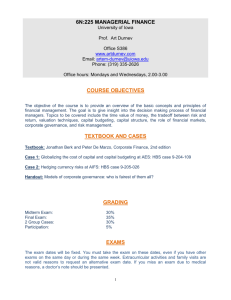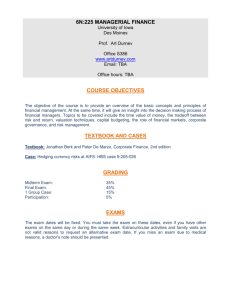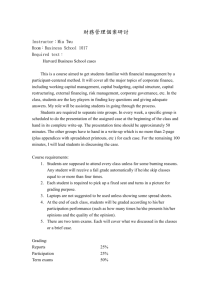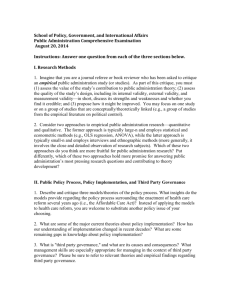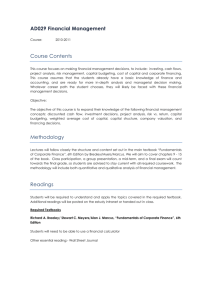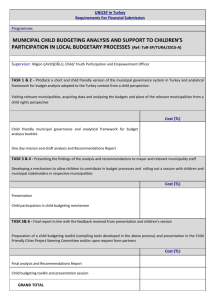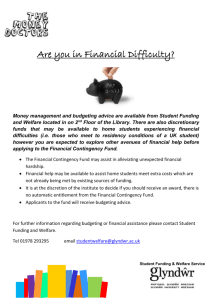CF-final
advertisement
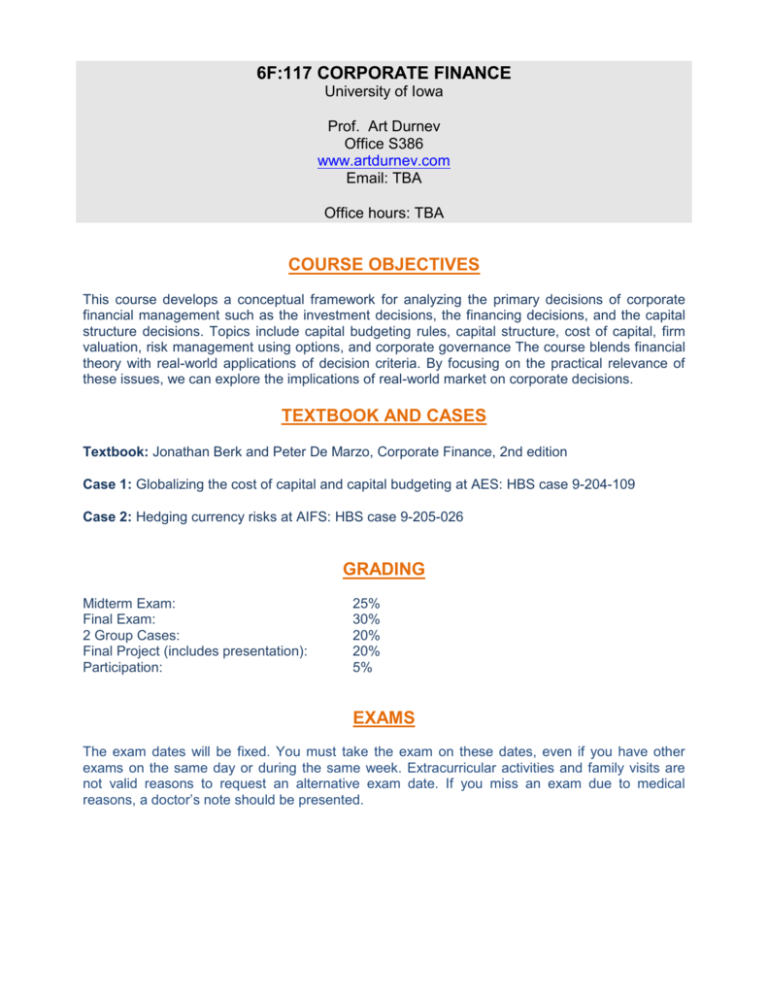
6F:117 CORPORATE FINANCE University of Iowa Prof. Art Durnev Office S386 www.artdurnev.com Email: TBA Office hours: TBA COURSE OBJECTIVES This course develops a conceptual framework for analyzing the primary decisions of corporate financial management such as the investment decisions, the financing decisions, and the capital structure decisions. Topics include capital budgeting rules, capital structure, cost of capital, firm valuation, risk management using options, and corporate governance The course blends financial theory with real-world applications of decision criteria. By focusing on the practical relevance of these issues, we can explore the implications of real-world market on corporate decisions. TEXTBOOK AND CASES Textbook: Jonathan Berk and Peter De Marzo, Corporate Finance, 2nd edition Case 1: Globalizing the cost of capital and capital budgeting at AES: HBS case 9-204-109 Case 2: Hedging currency risks at AIFS: HBS case 9-205-026 GRADING Midterm Exam: Final Exam: 2 Group Cases: Final Project (includes presentation): Participation: 25% 30% 20% 20% 5% EXAMS The exam dates will be fixed. You must take the exam on these dates, even if you have other exams on the same day or during the same week. Extracurricular activities and family visits are not valid reasons to request an alternative exam date. If you miss an exam due to medical reasons, a doctor’s note should be presented. CASES Cases are an integral part of this course and constitute 20% of your grade. The cases are to be done in groups of up to 5 people. All group members are expected to contribute to the case analysis. You will be required to evaluate your teammates’ contribution. A case write-up has to contain an executive summary, the key questions addressed, and a conclusion. The case write-up must be no more than 4 pages long (excluding references and appendixes) plus appendices with the font size of 11 and line spacing of 1.5. All tables and figures must be properly referenced in the text. Note that case studies rarely have one correct answer. IN-CLASS PRACTICE PROBLEMS Practice problem sets and their solutions will be posted. They will be discussed during class, and they are NOT to be handed in for grading. However, it is very important that each of you tries to solve all the questions and understands the solutions provided. These questions will be very valuable in helping you prepare for exams. FINAL PROJECT This project is to be done in groups of up to 5 people. You have to identify a specific “big” project (business idea) you would like to start from scratch. Your main objective is to obtain outside financing from private and public investors (preferably international) and secure some state funds (sovereign wealth funds, central banks’ reserves). Examples of the scope of the projects include: a monorail road from NYC to LA, city farming, global health network, new financial product, offshore retirement community, space tourism, under-water transatlantic tunnel, establishing a new financial center, building an airport, establishing a new Wikileaks-type website, establishing housing units for economically disadvantaged people, fighting world hunger and infectious diseases, setting-up a new type of hedge fund, etc. You are expected to use your life experience. You are required to select your project, discuss it with me, and submit an interim report (2 pages long) by mid-term. Your final analysis (max 10 pages long) should address the following issues: project description, capital budgeting analysis, financing (private vs. public, private-public partnership), capital structure decisions, corporate governance structure, and the assessment of various types of risks (political risk, market risk, economic crisis risk). Each group is required to present their project. The number of presentation slides should not exceed 10 slides. You will be given 7 minutes per group for your presentation. CLASS PARTICIPATION You have to actively participate in class discussions to earn class participation grade which constitutes 5% of your final grade. If you are frequently absent from class, your class participation grade will be reduced. SUBJECTS 1. REVIEW OF TIME VALUE OF MONEY Chapter 4 2. CAPITAL BUDGETING Chapters 6 and 7 3. COST OF CAPITAL ESTIMATION AND FIRM VALUATION Chapters 12 and 18 Case 1: Globalizing the cost of capital and capital budgeting at AES. Midterm Exam 4. CAPITAL STRUCTURE Chapters 14, 15, 16 5. RAISING EQUITY CAPITAL Chapter 23 6. DEBT FINANCING Chapter 24 7. FINANCIAL OPTION AND RISK MANAGEMENT Chapter 20 Case 2: Hedging currency risks at AIFS. 8. CORPORATE GOVERNANCE ISSUES Chapter 29 Models of corporate governance: who is fairest of them all Article to read: Explaining Differences in the Quality of Governance Among Companies: Evidence from Emerging Markets (A. Durnev and E. H. Kim), Journal of Applied Corporate Finance, Vol.19, Issue 1, 16-24 9. PROJECTS PRESENTATIONS Final Exam FINAL PROJECT REQUIREMENTS Your interim written report (it will not be graded) is due by the middle of the semester (the exact date will be announced in class). You are very welcome to submit it before the deadline I would like to meet with each of the groups at least once during office hours of after class. The following handout will help you structure your work load. General Requirements for the Interim Report 2 pages long, list your group members, has to preliminary address the points below: 1 (title and executive summary) and 2 (capital budgeting). You can also briefly discuss how you would structure points 3, 4, and 5. General Requirements for the Final Report and Presentation 1. Project Title and Executive Summary Try to come up with a catchy title and a motto for your project. While it is not required, you can create a very short (1 min or less) video promoting your idea. It would be good if you can include a group picture of your team. The executive summary should grab investors’ and government officials’ attention. Who are your customers? What is the value of the project? Cost? 2. Capital Budgeting You are free to choose any model you want. Case 1 is a good example of how to approach capital budgeting. Also, refer to the slides where we covered different capital budgeting approaches. Keep in mind that capital budgeting involves predicting cash flows and estimation of the cost of capital. How would you calculate NPV? Would you rely only on company beta? Would you rely on project-specific beta? Betas can be obtained from Yahoo Finance, Bloomberg, Value Line. Alternatively you can estimate betas using raw market data. What would be the cost of equity? Debt? How would you incorporate additional risks? Can you quantify different types of risks? You should justify the risks levels you are assigning. If your project has an international flavor, relevant data sources would include various indexes (expropriation index, index of state control) from the Economist Intelligence Unit (www.eiu.com), corruption index from the Transparency International (http://www.transparency.org/), media freedom index from the Reporters without Borders (http://en.rsf.org/), etc. Capital budgeting should contain a brief sensitivity analysis. 3. Funding What are the sources of your funds? Public money, private money, or a mix of the two sources. Where would you get public money from? Can you rely on alternative sources of financing? What are the risks associated with public funds? 4. Corporate Governance Structure What governance structure would you set up if you are allowed to borrow freely from the standards of any country in the world? How would your project benefit? Would you include employees as representatives on the board? Would you include customers, suppliers, and banks? Would you invite politicians on board? 5. Risk Assessment You are required to assess various types of risks (political risk, market risk, currency risk, economic crisis risk) and propose clear mechanisms to mitigate those risks. What is the relative importance of cost of construction, cost of labor, inflation, interest rate risks? Discuss the terms and conditions to mitigate some of these risks. Illustrate the challenges posed by your project to the local residents and businesses. Can you enter a mutually beneficial contract with local population? Student Profile 6F:117 Corporate Finance Your picture here Name ______________________________________________________________ Email ______________________________________________________________ Previous Finance Courses ______________________________________________ ___________________________________________________________________ ___________________________________________________________________ Professional Experience _______________________________________________ Any special interests or other background info you'd like me to know ___________ ___________________________________________________________________
